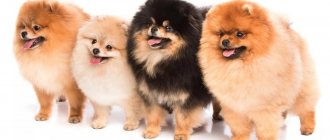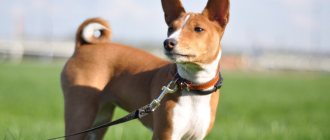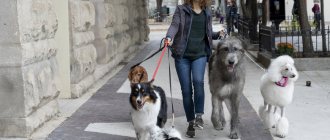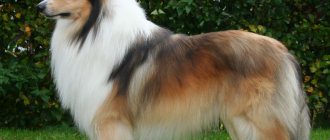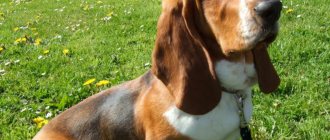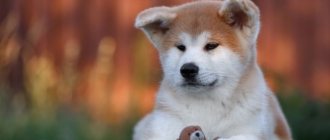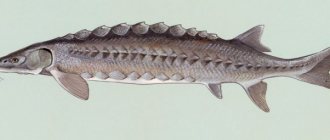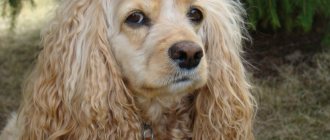Today, the Spitz is very popular among dog lovers because of its exceptionally cute appearance. However, not everyone knows that these decorative dogs come in many varieties of sizes and colors. The history of the breed originated in Germany, and later it spread throughout the world. Breeders from other countries liked the dogs so much that they developed their own version, focusing on their climatic and geographical features.
Pomeranian Spitz
This type of Spitz is divided into several species, since breeders from several countries became interested in its breeding. In America, when creating the breed, the emphasis was on a fluffy undercoat and thick coat; in Germany, they prefer the classic variety, which has straight and long hair.
Based on the type of muzzle, the Pomeranian Spitz is divided into three types:
- bearish;
- fox;
- toy.
At birth, it is impossible to determine the type, since species characteristics appear in about a year. Moreover, all dogs are characterized by thick hair and a ring-shaped tail.
Pomeranian bear type
One of the most sought after representatives of the breed. The Spitz gained great popularity due to its resemblance to small bear cubs. The breed description is as follows:
- The muzzle is flattened, with thick hair on the cheekbones.
- The eyes are black and located close to the nose. Its tip is raised higher than that of a fox spitz.
- Ears are small.
- The coat is very thick, but less long than that of other Spitz dogs.
This Pomeranian will make a wonderful companion, as it gets along easily with people and pets. Its distinctive features are energy, liveliness and friendliness.
Fox type Pomeranian
The breed standard calls for a long, elongated muzzle, which is why this variety is called fox. The height of the animal varies from 18 to 22 cm. Dogs also have fur on their cheeks, round eyes, a narrow chin, and a small nose. A distinctive feature of the fox type is an elongated tail, which other varieties of Spitz do not have. Colors can be different, the most common are red and beige.
The presence of white spots is considered a disqualifying defect.
The fox type is distinguished by being more people-oriented, obedient and playful. Caring for dogs is easy. It is enough to comb the coat twice a week and trim it as it grows.
Pomeranian toy type
This Dwarf Pomeranian is so named because it looks so much like a living toy. This type saw the light of day thanks to Japanese breeders, who took the classic breed with white color as a basis. Later, other shades began to appear. The toy Spitz is very similar to the bear's face in structure. He also has chubby cheeks and wide-set eyes. However, its muzzle is flat rather than rounded. The fur throughout the body is thick and fluffy.
Maintenance, care and grooming
Spitz dogs need personal care and require some maintenance rules. This breed is prone to obesity, which is very harmful for it, so the pet needs to be fed in sufficient quantities, but not overfed.
A Spitz's diet must include meat and dairy products. Although it is best to draw up a pet’s menu at the veterinarian, because these dogs sometimes have a tendency to allergies, and besides, nutrition affects the condition of their coat.
Grooming involves periodic brushing approximately once a week. But it is better to bathe once every couple of months, although it can be done more often if necessary.
Fluffy's ears should be cleaned with cotton swabs as they become dirty. But machine cutting of wool is contraindicated. The main thing is not to touch the lower undercoat, as it grows extremely slowly.
According to custom, Spitz dogs are cut only to give the coat a shape, cutting only in places so that the shape of the coat resembles a ball.
German Spitz
One of the first representatives whose ancestor is the Pile Spitz, considered the oldest European breed. Today there are several varieties of the German breed, differing in size and color. Thus, a Grossspitz (large Spitz) can grow up to 50 cm, and its minimum size is 42 cm.
The smallest German Spitz, the Miniature Spitz, has a height of 18 to 22 cm. Acceptable colors include:
- white;
- black;
- brown;
- zonal gray;
- ginger.
A height of less than 18 cm is considered a defect for Miniature Spitz dogs.
Photos of the main colors
Pomeranians can come in a variety of colors.
In accordance with the classification of the American Kennel Club, they are divided into 3 large groups:
- black, brown and zone gray;
- red, cream, sable;
- other colors.
IMPORTANT!
The final color of the Pomeranian's coat is formed after the first molt and may differ from what it was at birth.
Ginger
The most common color. Any intensity of red shade is acceptable, as well as lighter hair on the “pants”, muzzle, ears and tip of the tail.
The presence of brown color is unacceptable; the predominance of white hairs is considered defective.
In puppies, the guard hair may be light orange and the undercoat gray.
Cream or beige
The standard does not list acceptable shades, so dogs with cream coat of any intensity and shade are allowed to participate in the exhibition.
In general, cream color is divided into rich (warm) and cold, which visually looks white, but has a beige tint.
The coat of such puppies at birth can be white, beige, or even white with splashes of yellow.
Black
The coat is a solid glossy black color. It is noteworthy that in such dogs the skin, lips, nose and undercoat should also be black.
Puppies' fur may be brown or dark gray.
If a puppy born from completely black parents has small light hairs on the undercoat, this is not considered a serious defect and a violation of the standard. The disadvantage is also early gray hair in the muzzle area and slight fading of the undercoat.
Large spots of white or some other color are considered a significant defect.
To ensure that the color of the dog’s coat does not change after molting, it is necessary to ensure that there are no dogs of a different color in the family tree.
White
Pomeranians with a completely white coat are not albino, but leucistic - their nose, lips, eyes and skin are colored.
White is the main color of oranges, but it is not easy to achieve.
Most often, the coat is not snow-white, but has a creamy tint. Absolutely white dogs can only be born from the same parents. It is also important that their ancestors in the family tree are also white, otherwise later generations may develop some coloration.
According to the standard, any, even the slightest colored inclusions or spots of yellow color are considered defective.
Sable
This color belongs to the zonal color and consists of 2 colors: the undercoat is an iridescent light tone, and the guard hairs at the tips can be of different shades - from red and creamy sand to rich dark gray. It is important that the color of the muzzle and ears be identical.
Color can be of 3 varieties:
- red sable;
- creamy sable;
- gray sable.
Blue
Blue is a rare and expensive color.
The coat of blue Spitz dogs is evenly colored gray of varying intensity with a smoky tint.
Zone gray
This color is also called wolf color. It is quite rare in Pomeranians and is prized by breeders.
With this color, the coat has a grayish color with a silver tint, the eyes are clearly outlined, the ears are colored dark, and the muzzle is a rich grayish tint, the tail is black at the tip, the undercoat is whitish, the hair on the forearms and feathers is light.
Puppies are born almost black, but with age they lighten and the undercoat becomes thicker.
Brown or chocolate
Brown (chocolate) oranges do not have the pigment that makes their coat black, so its color matches the color of the nose, lips and eyelids. Of particular value are dogs that have a rich chocolate color.
After shedding, dogs' coat color does not change, but as they mature, light hairs may appear on the undercoat.
Japanese Spitz
The breed first saw the light of day in the late 20s of the 20th century. Their homeland was Japan, where local breeders took the Samoyed Laika as a basis and crossed it with a German Spitz. The dogs are small in size, height ranges from 38-40 cm. The body is dense and strong. The main feature is its snow-white color and thick coat. The nature of the animals is friendly and good-natured. They are well suited for children and can serve as excellent nannies for them. The life expectancy of the Japanese is 10-16 years, which is considered a good age for dogs.
Advantages and disadvantages of the breed
Like any other breed, Spitz dogs also have their advantages and disadvantages.
The advantages include:
- the animal’s cheerful and mischievous disposition, you will never get bored with him;
- nice appearance that attracts the attention of others and touches people;
- gentle character and the ability to coexist with many other pets;
- a huge amount of energy, thanks to which you will not get bored with the dog, so it is best suited for owners who live an active and varied life;
- thanks to its warm and thick fur, the animal never freezes in the cold season and happily walks in the snow;
- eats little and almost everything.
However, the Spitz also has some disadvantages:
- a sociable dog who cannot tolerate separation from household members, so you should not leave your pet alone at home or abandon it for a long time;
- an excessively loud dog, which, ignoring its small size, barks even at large dogs, and in general announces its every mood with a loud bark;
- sometimes he is very interested in games and can chew things in excitement;
- in childhood, the animal is fragile and prone to bone fractures, and sometimes malocclusion occurs;
- Due to the growing selection, small Spitz breeds of the “bear cub” type have problems with the respiratory system, as their muzzles are increasingly shortened by breeders, which can cause deformities of the nasopharynx and trachea.
Finnish Spitz
In the 19th century, Spitz actively spread throughout the world and came to Finland. There, local breeders develop their own variety of the breed. Finnish Spitz are slightly larger than their relatives, their size is 40-50 cm and their weight is about 10 kg. Such dogs are mobile, active, and can bark loudly, expressing their feelings. They are independent, but at the same time very attached to their owners. The average life expectancy is 12-14 years.
Finnish Spitz can be taken to hunt small animals.
Nutrition
Organizing proper nutrition is based on 3 pillars:
Optimal receipt of all necessary vitamins by the body
As well as minerals, etc. while maintaining a clear balance between them. The following standards are recommended:
Daily requirement for vitamins, fats, carbohydrates, microelements calculated per 1 kg. body:
| № | Name | Puppy | Adult |
| 1 | A | 200ME | 100ME |
| 2 | D | 20ME | 7ME |
| 3 | C | 1mg | 1mg |
| 4 | B2 | 90mg | 40mg |
| 5 | B6 | 50mg | 20mg |
| 6 | B12 | 0.7 mg | 0.7 mg |
| 7 | H | 0.5 mg | 0.5 mg |
| 8 | E | 2mg | 2mg |
| 9 | Calcium | 528mg | 264 mg |
| 10 | Phosphorus | 440mg | 220mg |
| 11 | Iron | 1.31 mg | 1.31 mg |
| 12 | Zinc | 0.11 mg | 0.11 mg |
| 13 | Fats | 2.6g | 1.32g |
| 14 | Carbohydrates | 10g | 10g |
Avoiding chaotic, excessive eating
Owners often want to pamper their handsome dog with something tasty. But “overeating” is dangerous not only due to excess weight, but also problems for internal organs.
Remember, small snacks during the day result in an additional full portion, which will definitely be superfluous.
Determining the type of feed
Natural (homemade) or purchased. Each of which has advantages and disadvantages.
Veterinarians do not recommend giving your dog mixed food - this negatively affects the pet’s health.
Spitz puppies
Homemade food is based on foods with a high protein content. Recommendations for the use of the main products are given below.
Recommendations for introducing basic types of animal and plant products into the diet:
| № | Product | Recommendations |
| 1 | Meat and offal | Ideally, the meat should be raw and frozen. But, in order to avoid the risk of helminth infection, it is recommended to heat treat it. It is enough to boil a little for 2-3 minutes. Due to the high fat content, it is not recommended to include pork in the diet. Give preference to poultry (duck, chicken), rabbit meat, beef. The by-products of these animals (liver, tripe, heart, trachea, etc.) are also recommended. |
| 2 | Fish | Preference is given to inhabitants of the seas (river contains many small bones that are dangerous for pets). Possessing an inexhaustible resource of proteins, microelements, acids, fish does not cause allergies. Improves skin and coat. It is recommended to add fish oil to the main diet of the Spitz, compensating for the deficiency of amino acids. |
| 3 | Egg, dairy products | The egg is not given raw - it must be boiled or fried. Fermented milk products should have minimal fat content. Cheeses are given little by little and not as food, but as a small delicacy - again due to their high calorie content. |
| 4 | Vegetables, grains | Like humans, Spitz needs vitamins contained in fresh vegetables. The little naughty boy will be happy to join you in tasting tomatoes, sweet peppers, zucchini, and carrots. But do not rush to give early vegetables that are not yet in season - greenhouse crops may contain nitrates that have a detrimental effect on health (and not only your pet). In winter, you can treat your pet with dried fruits. Rice is the preferred cereal. |
What not to add to your diet
- purchased semi-finished products;
- spicy foods;
- dishes with high salt content;
- smoked delicacies;
- bones of poultry, fish;
- confectionery, baked goods;
- sausages;
- pickles (zucchini, cucumbers, mushrooms);
- citrus fruits, etc.
Ready-made food is convenient for owners. In particular, there is no need to choose what to give or prepare for your pet, taking into account its need for nutrients and vitamins. Ready-made food already contains the required minimum. In this case, only one question remains to be resolved - which food is suitable for your pet.
Despite its apparent simplicity, the answer to the question should be approached with all responsibility. With a huge selection of offers from various brands, this will not be an easy choice. Here it is necessary to take into account the age of the pet, its state of health, etc., giving preference to special food for small breeds of dogs.
Spitz
Some tips
Tip 1 Advertising is, of course, the engine of progress. But the health of your Spitz is more important to you. Do not believe the beautiful slogans of manufacturers, give preference to premium food. Cheap is rarely quality.
Tip 2 Study the composition carefully. It must be detailed, in Russian. In this case, pay special attention to the amount of protein in the feed. The optimal value is more than 25%, and it should be made from natural products: meat, liver, etc.
Tip 3 The ratio of vitamins and minerals, as well as their concentration, should be suitable for the pet’s breed. Recommended shares are given earlier.
Tip 4 Study reviews about the product, consult with specialist breeders.
Tip 5 Monitor the dog’s body’s reaction to the food. If unusual reactions occur (hair loss, loss of shine, sour eyes, problems with stool, etc.), immediately change the food. Perhaps it is not suitable for your Spitz, causing allergic reactions. Consultation with a veterinarian is recommended.
Tip 6 Strictly follow the instructions and dosage when feeding located on the package. As a rule, the package indicates the daily dosage of the product, not the one-time dosage.
Tip 7 A little trick when feeding dry food (especially at an early age) is to pre-soak it in warm water. Soaked food is more easily absorbed by the baby and is more easily absorbed by the digestive system.
American Eskimo Spitz
This breed appeared in America in the 19th century. When it was created, the German variety was taken as a basis. They are excellent companions, have extraordinary intelligence and are easy to train. However, they need to be socialized from early childhood, as Eskimo Spitz dogs can grow up to be distrustful or even aggressive towards strangers. Animals will feel good both as a pet and as a hunter. American Spitz dogs have good health and live about 15 years.
Description of the characteristics of the Spitz family
The Spitz family is most often associated with the “couch dog” species – the Pomeranian. However, the breed is much more diverse and includes species whose height at the withers reaches more than 50 cm.
Therefore, the breed, taking into account all its variations, deserves a more detailed description.
Regarding size and proportions, these animals are well proportioned. The figure of the dog, by and large, resembles a square - that is, the height of the animal at the withers is approximately equal to the length of its body, so it seems as if the Spitz could be fit into an imaginary square frame.
These dogs are distinguished in most cases by their small size and very fluffy fur. They have a very thick and close-lying undercoat, but the outer layer is represented by a long and loose outer coat.
In dogs of the Spitz breed, the coloring most often predominates in white, red, brown or gray, which is sometimes diluted with light or dark spots. It is important that the distribution of stains throughout the coat is uniform.
The color can also be orange, black, zone gray and sable. Less common are representatives with a cream or black and tan color.
Thanks to their compact size, Spitz dogs are able to move smoothly and silently. Due to the long, airy fur, from the outside it seems that this is a funny fluffy ball that hovers above the ground. They are very fast and active, they jump up a lot and bark loudly.
The animal's tail resembles a funny pretzel, cheerfully curved upward towards the back. The muzzle has an upturned fox nose, and on the top of the head there are mischievous high-set ears. Such a cute appearance of a Spitz is very uplifting and touching.
Did you know? Spitz have undergone a metamorphosis from ancient strong draft dogs to miniature and decorative sofa pets.
In addition to being very cute, the pet can also easily serve as a domestic watchdog. They have a very keen sense of smell and excellent hearing, thanks to which they sense strangers from afar and bark loudly when they approach.
Initially, when the breed first appeared, it was used precisely as a home “alarm.”
The dog's character is very friendly, mischievous and cheerful. They become strongly attached to a person and truly become his true friend.
In addition, Spitz dogs are highly trained and follow all commands well. They have a fairly sharp mind and are very smart.
These pets love people, become strongly attached to the family in which they live, and treat them with reverent tenderness. They have a well-developed intuitive sense of the emotions of their household members, so they always adapt to their mood.
This is a cheerful animal that, even in adulthood, does not lose its mischievous and good-natured character. They love to play a lot and enthusiastically take on any entertainment offered.
They are also very patient with human children. Even if the child is careless with the pet and causes pain, the Spitz will never bite the baby or even growl, but will dutifully endure the discomfort.
Therefore, owners always need to monitor their children’s interactions with these animals so that their pets do not get injured.
Wolf Spitz
Another name for the German Wolf Spitz is the Keeshond. He is not just the oldest among his relatives, but one of the oldest breeds on Earth. It is believed that his ancestor was the turf dog, which lived back in the Stone Age. Modern Wolf Spitz dogs appeared in Europe in the 16th century. They are distinguished by a harmoniously built body, their height is about 45 cm, less often - 55 cm. Weight reaches 30 kg. This breed is energetic, sociable and friendly towards children. However, he is wary of strangers. The Wolf Spitz has good watchdog qualities.
The breed is distinguished by its cleanliness. Dogs can wash themselves with their paws, just like cats.
Anatomical features of the breed
Among the health complications inherent in Spitz dogs, problems with:
- teeth - starting from the period of their replacement. This is caused by rather deep roots. This structural feature leads to the fact that baby teeth, in most cases, do not fall out on their own, preventing the normal growth of permanent teeth. In addition, there is a high risk of gum disease and tartar. Failure to respond to this problem in a timely manner can cause early tooth loss;
- eyes – their increased tearfulness. This is due to the structure of the skull - a sharp transition from the forehead to the muzzle causes the eyes to “bulge.” In addition, this feature leads to vulnerability of the eyeball (inflammatory diseases, dryness, risk of injury, etc.). Therefore, special attention must be paid to caring for your dog’s eyes;
- specific "cough". The larynx of this breed has its own drawback - the cartilages in it are not “closed”. Therefore, against the background of stress or illness, this “cough” may manifest itself. It resembles an animal trying to cough up something that has gotten into its throat. In fact there is nothing there. Just calm your pet, everything will pass.
Spitz
This is interesting: What and how to feed a Scottish kitten per month?
Eurasian Spitz
This variety appeared relatively recently, in the mid-20th century. This is a fairly large animal, reaching 60 cm at the withers. It is distinguished by restraint, calm temperament and endurance. The European is friendly towards his owners and is able to protect his family if necessary. It only uses its voice in case of danger to warn its owners. Thanks to this, the dog will become not only an excellent companion, but also a devoted protector. Life expectancy is somewhat shorter than other varieties of the breed, about 11-13 years.
Temperament, training and training
Spitz dogs have long taken root in human homes, because they are friendly, cheerful, attractive, and also excellent guards, and sometimes excellent hunters.
But before you get such a pet, you need to know everything about the breed, since it may not be suitable for every person.
The character of these animals is mischievous and cheerful. In most varieties they are restless, active and energetic. They are often loud with a ringing bark.
Some breeds require early socialization due to the fact that if they are not accustomed to gentle but persistent training, they become overly selfish, selfish, and sometimes even aggressive.
But if all is well, then these dogs become excellent companions not only for families with children, but also for lonely elderly people. Spitz dogs can be monogamous, and in general they get very bored when alone and really need the attention of their owner.
Important! These dogs need training from an early age. They are very smart from birth, so you actually need to teach them from birth to follow commands and basic rules of behavior.
Developed intelligence helps them learn successfully. However, training cannot be carried out under strict control. Your efforts should be gentle but persistent. Do not scold the dog or hit it, but also do not allow it to shirk the command.
Spend at least 3 days studying any command, but you need to study for an hour every day. Also, rules and commands must be constant: sometimes you cannot follow them, and sometimes you cannot. A rule is a rule, otherwise the dog simply will not understand what they want from it.
Italian volpino-italiano
This Spitz originates in Florence, Italy. Mention of its ancestors dates back to the 9th century, but dogs were finally formed in the Middle Ages. Volpino is not very tall or heavy: the height at the withers is no more than 30 cm, and the weight is about 5 kg. Usually the color of dogs is white, but sometimes fawn and red are found. They have a restless disposition, which is why animals can react to what is happening by barking. These dogs are extremely active and love to interact with people. Their lifespan is about 13 years.
Origin of the breed and purpose
This dog breed is very ancient and dates back to the times of Ancient Rome and Ancient Greece. However, then mentions of Spitz were quite rare.
Learn a lot of interesting things about the origin of dog breeds such as Bedlington, Lhasa Apso, Groenendael, hunting spaniel, Schipperke, American Akita, Russian pinto hound, Bully cutta, Dalmatian, Bullmastiff, German boxer, Great Dane.
The peak of popularity for breeding these pets mainly falls in the Middle Ages in Northern European territories.
It is believed that the breed first began to be bred in Germany, but this is not entirely true, since at that time it was actively selected in Finland, Denmark, and Holland. Moreover, at that time Spitz-like huskies also began to be bred on Siberian lands.
Initially, Spitz dogs did not have a decorative purpose, but were bred as watchdogs. They guarded yards and houses. They were also taken as guards on various ships and barges. And sometimes they were used during hunting to drive wild animals.
And only with the advent of the 19th century, small dogs began to be taken into the house only for decorative purposes. They quickly inhabited the homes of nobles and nobility and became the so-called “ladies' dogs.”
Did you know? The fashion for Spitz dogs was introduced by Queen Victoria of England, who absolutely never parted with her pet Marco.
People loved them, artists often depicted them in paintings and introduced them as characters in literature. The famous work of A.P. Chekhov “The Lady with the Dog” became a unique symbol of this breed, both female and decorative.
Husky and Spitz mix
The breed was named Pomsky. These dogs have become an exclusive designer find, but today they remain not recognized by the International Canine Federation. The color of the Pomsky usually matches the color of the Husky's coat. The most common shades are:
- grey-white;
- black;
- white;
- ginger;
- brown.
Usually puppies have a kind of mask on their face. Dogs are easy to train and are smart. Unlike classic Spitz dogs, Pomskies calmly tolerate loneliness.
Northern guard dogs are also relatives of Spitz:
Well-known huskies: Russian-European, East Siberian, West Siberian, Finnish
Laiki is a fairly new breed, bred quite recently. These dogs have an excellent sense of smell and eyesight and are often kept at home by amateur hunters. However, we must remember that huskies are very freedom-loving. Therefore, when walking, you don’t need to let them off the leash. Their love for independence may overpower their love for their owner, and the dog may run away. They are easy to raise, but huskies are very touchy and when communicating with them it is important not to raise your voice, but to seek a compromise. Some types of huskies are used in northern regions as sled dogs.
Pomeranian and Chihuahua mix
This mixed breed, called the Pomchi, is an excellent companion dog. It is small in size, which allows you to keep it in a city apartment and easily pick it up. The dog's weight is only 3.5 kg, and its height is no more than 25 cm. Externally, the Pomchi is similar to a Chihuahua with long hair. The head is round, the ears are large, like those of a Chihuahua, but pointed, like those of a Spitz. Mestizos are loyal, people-oriented.
Health and characteristic diseases
How long do different varieties of the Spitz breed live if everything is in order with their health? On average, their lifespan is 12–13 years. Often these dogs have good immunity and therefore rarely get sick.
But sometimes Spitz dogs are prone to certain diseases that are unique to this breed.
Due to their small size, these dogs are prone to injure themselves, as they have weak ligaments and thin bones. Sometimes there are deviations in the form of too small a size or even dwarfism, which is a pathology, namely underdevelopment of the pituitary gland.
Spitz dogs also experience problems with the eyes, nasopharynx and ears. In childhood, malocclusion and various dental problems can occur. A tendency to allergies causes increased tearfulness in dogs, and the convex outer shape of the eyeballs increases the risk of injury and excessive dryness.
Often deformed due to a series of selections, the Spitz larynx also becomes a problem.
Its unclosed cartilages cause the pet to develop a specific cough, which appears in stressful situations - the animal thinks that something is stuck in its throat, and it tries to cough it up, although in fact there is nothing there.
Did you know? Jean Paul, the famous German writer, never came to visit unless he was allowed to take his pet Spitz with him.
Among the genetic diseases, Spitz dogs are prone to hip dysplasia, retinal atrophy, and disorders of the adrenal glands and thyroid gland. Epilepsy also sometimes occurs.
Yorkie and Spitz mix
The cross between a Yorkshire terrier and a Spitz received the informal name Cherki. The animal has soft long hair, the colors of which can vary greatly: the color varies from golden to black. It is difficult to predict the height and weight of future offspring; sometimes a born puppy can be twice the size of one of the parents. A dog can easily get into a fight with an enemy that is larger than it, so it needs constant supervision. In general, dogs are very friendly and active, but sometimes they can show the aggressiveness characteristic of mixed breeds.
How to choose a puppy and prices for family members
When choosing a Spitz, there are several points to consider:
- the puppy should not be younger than 2 months, and it is better if it is 2 months old;
- the coat should be thick and shiny;
- the nose is wet;
- the eyes are shiny;
- the body is proportional and square;
- the puppy must be active and inquisitive;
- coat color is uniform.
When purchasing a pet, a pedigree and a veterinary passport must be included.
How much do Spitz dogs cost? Typically, prices depend on many factors: purity of the breed, compliance with the standard, gender and pedigree. The better the pedigree, the rarer the type of puppy you want to purchase, the more expensive it will cost.
The cost of various types of Spitz ranges from $100 (for example, for a fox-type Pomeranian without a pedigree) and up to $3,000 for a breed-class and show-class dog with famous ancestors and rare colors.
Nicknames for dogs
It is better to choose a short name for the Spitz so that the puppy remembers it quickly. Nicknames for boys:
- Henry;
- Duke;
- Bart;
- Casper.
Popular names for girls:
- Amelia;
- Snowball;
- Bella;
- Thea.
When choosing a nickname, you can focus on the ancient origin of Spitz, personal preferences or the special advantages of the pet.
How to care for a dog
The most important thing for a puppy is to provide a place where he can rest. Starting from the age of two months, they begin to walk him.
- At first for twenty minutes, then the time increases. Coming from a walk, the dog’s paws are washed.
- In bad weather, she wears a suit; it will prevent her fur from getting dirty.
- A Spitz is bathed quite rarely, unless it is very dirty or it is necessary to take part in an exhibition.
- At the end of the water procedures, the dog is wiped and dried using a hairdryer.
Overgrown hair in the ears is plucked and trimmed using nail scissors. Teeth are regularly brushed with a special toothpaste and brush. The claws are trimmed weekly with a nail clipper, and the eyes are wiped with napkins, also specially designed for this.
Where can I buy
The breed is popular in Russia; in many cities there are nurseries that breed Spitz dogs. Among them are:
- Liebe Kinder (Ekaterinburg);
- Fire Fox (Kaluga);
- Mini Gum (Moscow);
- Bon Chanterelle (St. Petersburg).
The price of puppies may vary depending on the class of the pet. On average, a Pomeranian with all documents will cost 25,000 rubles. If you plan to purchase a show-class dog, the cost can rise to 100,000 rubles.
Whatever type of Spitz you like, you should remember that the dog’s behavior is primarily determined by upbringing and training. Therefore, any variety of the breed can become an excellent friend or family companion.
Which owner is it suitable for, depending on the species?
Small and medium-sized Spitz dogs are best suited for people who don't like to be bored. These are not animals that can be carried under your arm. They are active and inquisitive and require long walks outside. They love to play. Therefore, the owner of such a dog must be cheerful and equally energetic.
Spitz dogs of all types are not suitable for phlegmatic and melancholy people. They need care and constant communication.
If you like to relax in bed, and prefer to lie down for a few hours with a book and a mug of tea over a walk in the park, then this dog is not for you. Lying down certainly won’t work, your pet definitely won’t let you.
Small breeds are quite suitable for older people who, although a companion in old age, if for health reasons a person cannot provide the dog with full care, then it is better to choose a calmer pet.
Important! Spitz owners need a strong and healthy owner, as the dog can become exhausting in a day. But if you have children in your family and you are used to living an active life, then these pets will perfectly complement your life.
But if you are full of strength and energy or want to get rid of loneliness, then Spitz will be your best friend.
"Fox" with slanted eyes
The Grossspitz has a wedge-shaped head, tapering to a round black nose. This structure of the skull, as well as the smoothly protruding forehead and slightly rounded cheekbones, resemble the muzzle of a fox. On the dog's head there are erect triangular ears located close to each other. The standard large Spitz has certain proportions. The ratio of muzzle length to head length should be 2:3, and height to body length – 1:1.
The dog's well-developed jaws have a full set of even white teeth - 42 pieces and a scissor bite. A direct bite is also allowed, but the absence of teeth is a big flaw. The Spitz's dark, oval and slightly slanted eyes have an intelligent and cheerful look. When a stranger appears, they acquire a wary expression, and in case of danger, an angry expression.
The compact and harmonious body of the animal is made by a straight back, which ends in a short and wide loin. The German Spitz has a well-developed, voluminous chest and a moderately toned abdomen. The impressive image of the dog is complemented by a tail set high, curled into a ring (sometimes double) and lying on the back. The animal's limbs are well developed physically, which allows it to move freely and accurately forward, springing off the ground.
Such different Spitz: breed standard
The size of dogs varies greatly. The smallest representative weighs only 3 kg, and his height is 18 cm. At the same time, the largest is half a meter at the withers and weighs 20 kg. This big difference is due to the purpose of the dog. Large representatives of the breed are used on pastures, they help shepherds graze livestock. Large representatives are also used when hunting wild boar and bear.
Mini Spitz dogs have a decorative function. They live in apartments and delight owners with their appearance and mischievous character.
Medium and small dogs perform in the circus and in competitions. Dogs of this breed are very smart and non-aggressive.
Despite such different weight categories, all types of Spitz have similar exterior features, and the breed standard is the same for all. The only difference is the size and color of their marvelous fur coat.
The breed standard is the same for all species
The fur of animals consists of two layers: a short and soft-to-the-touch undercoat, and a long axial hair. In the collar area, the axial coat is long; dogs have a lush collar, a narrow “fox” muzzle and mischievous beady eyes that look elegant and cute. Long six and on the tail, which falls down the back of the dog. On the hind legs, the axial hair creates the appearance of panties.
The body has the shape of a square, the proportions of the length of the body to the height at the withers are 1:1. Straight back and erect ears, narrow muzzle and rich undercoat at any time of the year. The eyes are almond-shaped. Small ears stand on top of the head, giving the dog an alert appearance.
Spitz are mischievous, cheerful dogs who love to play and travel. The cute face and fluffy coat give the dog an unforgettable appearance. A sharp mind and quick wit helps to guess the owner’s mood and amuse him with active games. Loyal to one person, Spitz dogs are ready to serve him faithfully for many years.
Origin story
The first documentary mentions of the miniature Spitz date back to Germany in the 15th century. It was here that they began to be bred. Initially, these dogs were used as guards and helpers for herding livestock. But over time, the aristocracy liked this breed, and the dogs were bred for a slightly different purpose.
The characteristics of the breed changed: medieval dogs were much larger in size than modern representatives of the species, and weighed about 14 kg. At the end of the 19th century, Queen Victoria of England liked the German Spitz dog. She brought one of the fluffy dogs with her to her homeland. Soon Pomeranians began to be actively bred in Great Britain.
Varieties
There are ten different breeds in total, united in the friendly Spitz family. If you like the concept of such dogs, you can choose a specific breed from the ones below. You can read about each in more detail if you follow the link.
Large German Spitz
Grossspitz
One of the rarest varieties of the Greater German Spitz. They have a Spitz-type appearance and a height of 45 cm. Initially, they were used by European peasants as guard herding dogs.
Grossspitz have long hair with a very thick undercoat. Thanks to it, the dog tolerates low temperatures well and is suitable for both indoor and outdoor living. Owners need to know that it is impossible to suddenly change the pet’s living conditions - this can negatively affect the quality of the undercoat, which stops growing in the warmth of the apartment.
Otherwise, the Great German Spitz, like its brothers, is a very energetic and active pet. He socializes quite easily, is friendly to all family members, and displays high mental abilities.
Keeshond
Keeshond
This variety is also called Wolfspitz or “barge dog.” The first name is due to their external resemblance to a wolf, the second is due to the fact that in Holland they were used as rodent hunters on barges and other vessels.
Keeshonds are the tallest of the Spitz breeds. Their height at the withers is 48 cm. A distinctive feature of the variety is its interesting color, which may contain black, gray and beige shades.
Wolfspitz are strong empaths, they are able to capture the mood of all family members. Abroad, this variety is often used in canistherapy. In addition, they are strongly attached not only to the owner, but also to the house. It is better to keep them outdoors, since due to their thick fur they do not tolerate high temperatures well.
American Eskimo Spitz
American Eskimo Spitz
Eskies, as they are called overseas, are another variety of the German Spitz, bred in America. Most likely, Samoyed Huskies took part in the development of the breed, so the American Eskimo Spitz is slightly different from its European relatives.
Eska's height can range from 22 to 48 cm. At first glance, this is a typical Spitz, but the ears of the “Americans” are larger and covered with thick hair, and the color is only white. The variety is recognized by the American Canine Association, but the FCI is in no hurry to add it to Spitz dogs.
Volpino Italiano
Volpino Italiano
Decorative Italian Spitz in appearance are a cross between German and Pomeranian Spitz. Of all the species they are most similar to foxes. In fact, the name given to them in their homeland in translation sounds like “Little Chanterelle”.
On his neck, Volpino Italiano wears a kind of “collar”, formed due to the thick and dense undercoat. The tail has long feathers, giving it a fountain-like appearance. They are no more than 30 cm tall, but this does not prevent them from being good guards. Otherwise, they are the most ordinary Spitz: noisy, energetic, restless.
Eurasier
Eurasier
They were bred in Germany about half a century ago, combining the best features of the Chow Chow and Wolfspitz in a new breed. Later they added Samoyed Laika blood. This is how the Eurasier turned out - a friendly dog with a calm temperament.
Their height is approximately 60 cm, and their coat, unlike other Spitz-types, is long and hard.
For your information! Representatives of this breed can be of any solid color, except white and, in no case, spotted.
There is absolutely no place for aggression in their life. They are equally friendly with family members and strangers. Eurasiers are not the best guards, but they are excellent athletes and natural companions.
Karelo-Finnish Laika
Karelo-Finnish Laika
The Karelo-Finnish Isthmus is considered the birthplace of the breed. It was there that these primitive Spitz-like Laikas were first discovered. Subsequently, the improvement of the breed proceeded in parallel in Russia and Finland, thanks to which the Finnish Spitz and the Karelo-Finnish Laika appeared.
Their height is 50 cm, they are considered the shortest Laikas, and the calling card of the breed is their bright red color. Karelians are not as loving as Spitz dogs, but they are quite close to their owners. In this tandem, they tend to consider themselves in charge and often show disobedience. Like all Laikas, they are wonderful hunters.
Mittelspitz
Mittelspitz
The Medium German Spitz is one of the most striking representatives of the German Spitz, up to 36 cm tall. They are characterized by the presence of a fluffy mane-shaped collar and a long, ring-curved tail covering most of the back. In addition, as a rule, there are elegant “pants”.
Before you take Mittel into your home, you need to know that he needs regular training and long walks. This is the only way a pet can throw out excess energy and not cause damage to the owner’s things. It is not recommended to hit or scold Miniature Spitz dogs, and it is better to conduct training in a playful way.
Small German Spitz
Small German
This is a decorative variety, no more than 30 cm in height. They are considered the progenitors of all German Spitz. They are characterized by a square, squat body and abundant, hard hair in the neck, tail and body.
Due to their small size, Kleinspitz dogs are perfect for apartment living and are distinguished by their strong attachment to their owner and restlessness. We are ready to accompany him literally everywhere. They love to ride with their owner in a car.
They are quite friendly towards children. Quite suitable for living in an apartment with small children.
Pomeranian Spitz
Pomeranian
Pomeranians are the smallest Spitz. Their height does not exceed 22 cm, and just looking at them makes you feel cozy. The standard of the variety is considered to be the “fox” type, the rest are already a deviation, although they are no less loved among dog handlers.
The “bear” and “toy” types of the exhibition standard are also bred.
These are active and cheerful pets. Staying locked up is contraindicated for them; walking and exercise are vital. They are not prone to aggression and are friendly to absolutely everyone, but it is necessary to raise a Pomeranian puppy from the very first days, so as not to later encounter manifestations of selfishness.
Japanese Spitz
Japanese
Such a variety as the Japanese Spitz descended from the white German Spitz, which came to Japan from China in 1920-30. Later it was repeatedly improved with the participation of white Spitz dogs from other countries. The breed has a strong resemblance to the Eskie, and therefore has received recognition in all countries except the United States.
And, sometimes, he is called the most silent Spitz, since initially, according to the standard, he is not an “empty dog”.
Warning! There is no point in offending Japanese Spitz. Despite their friendliness, they can be touchy and vindictive.
